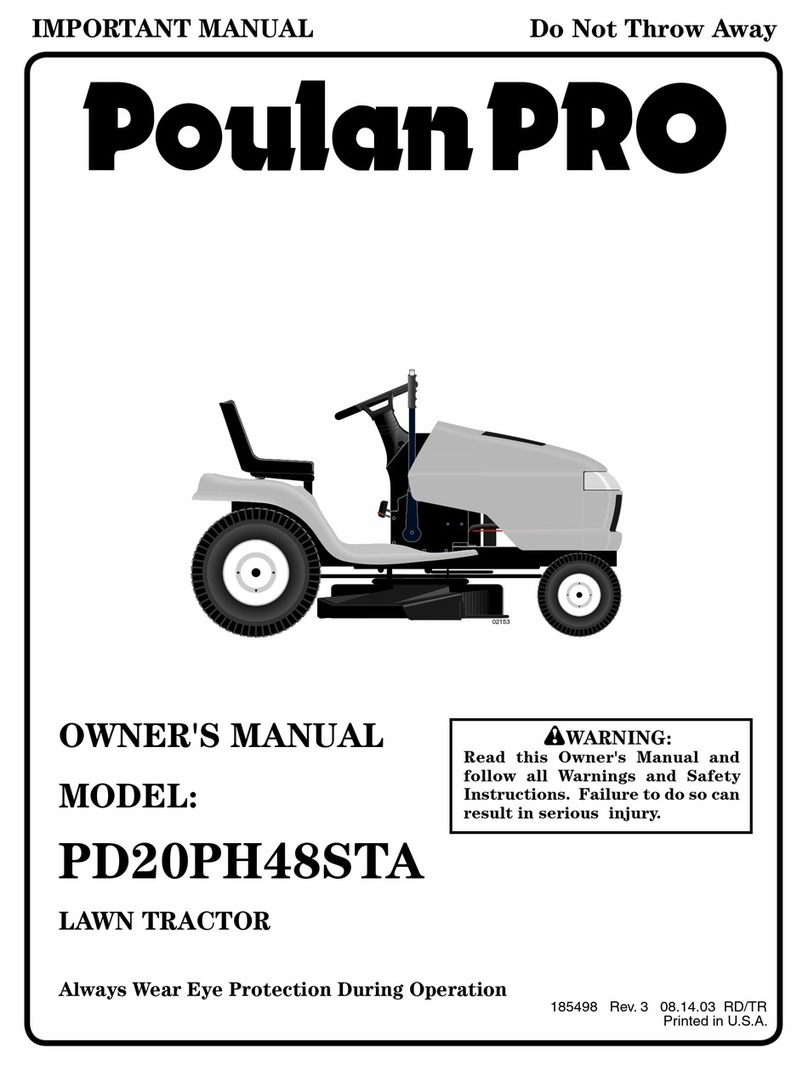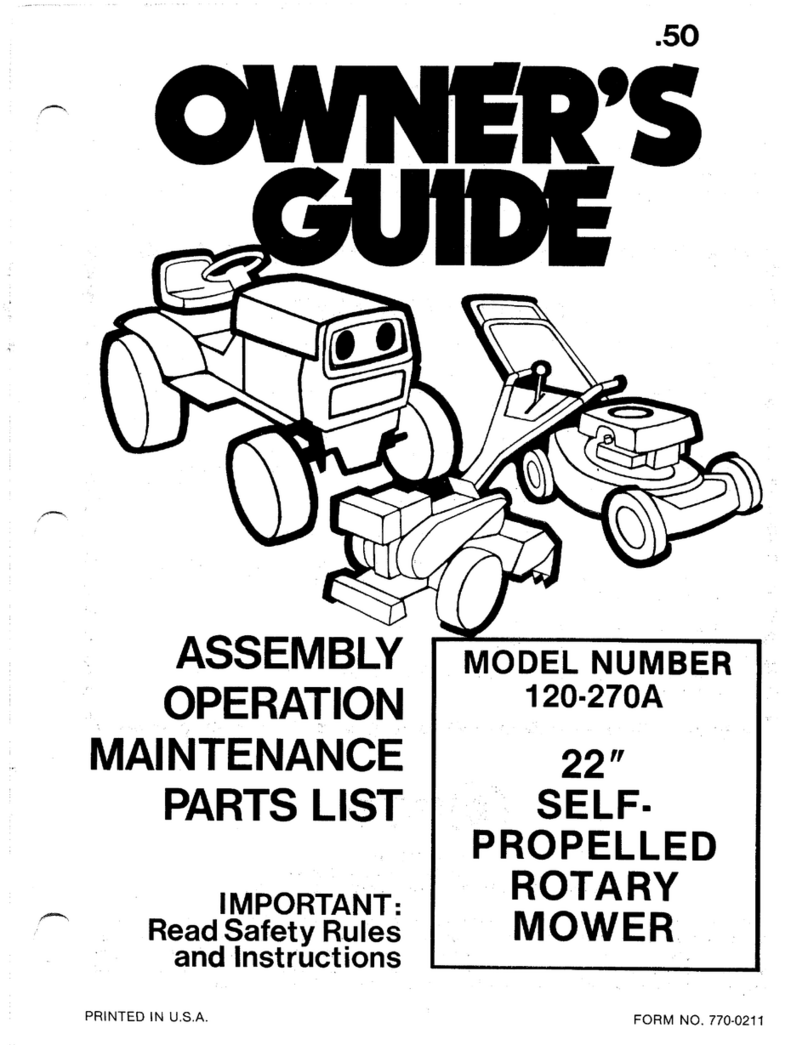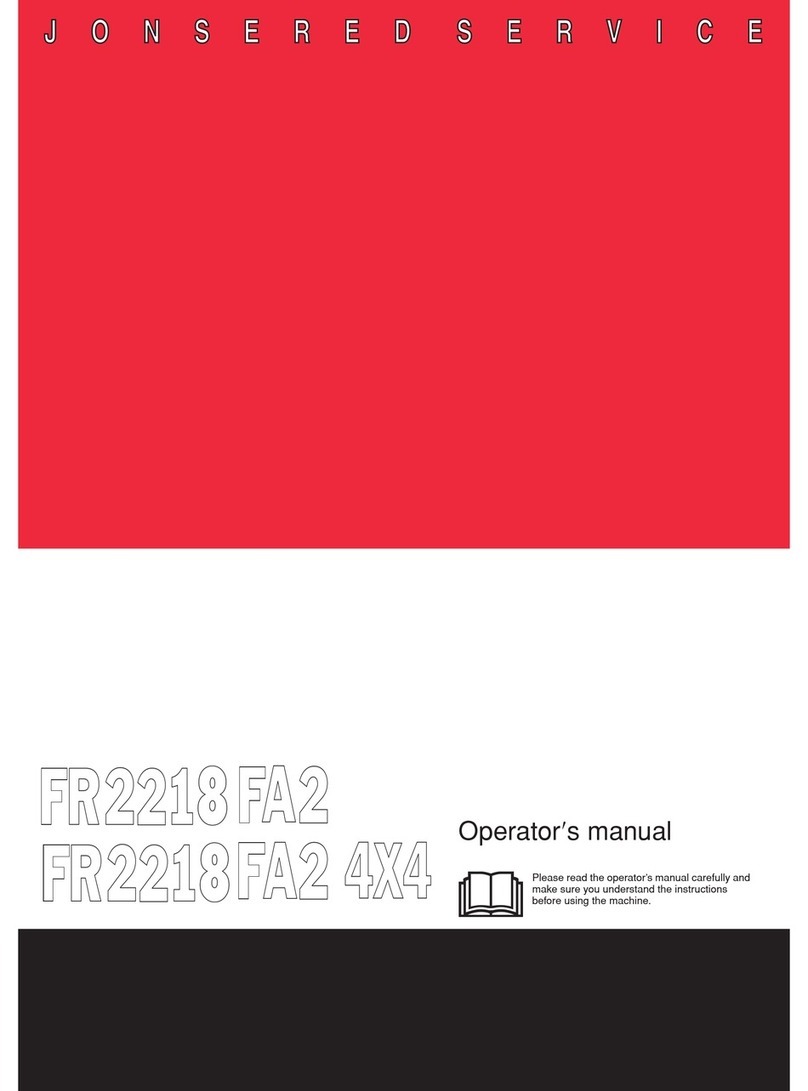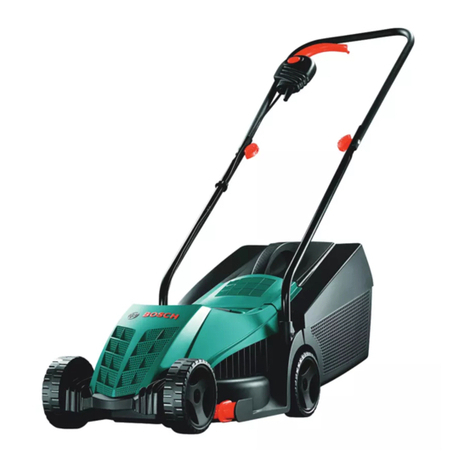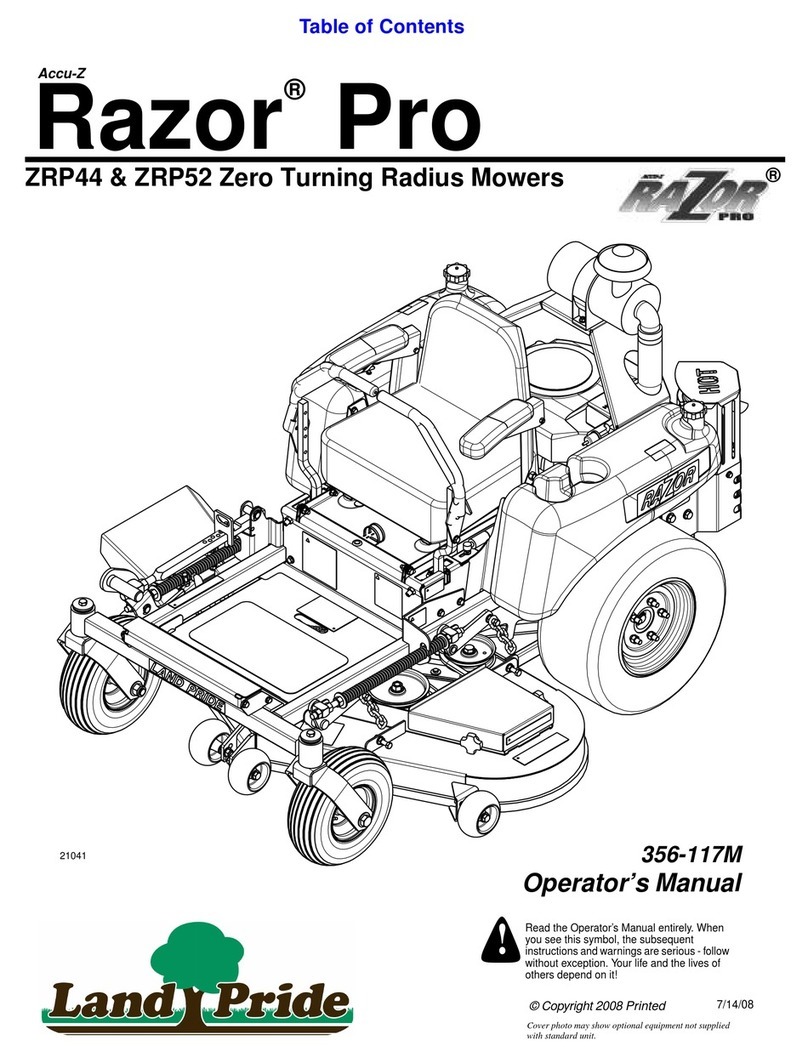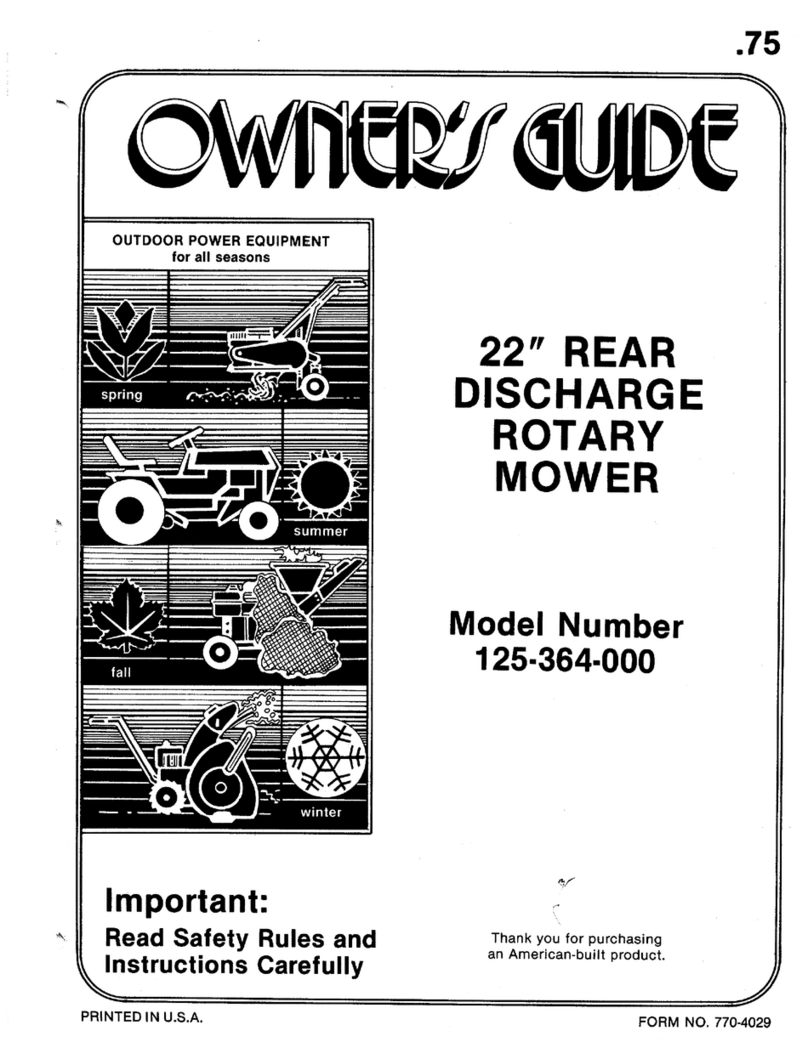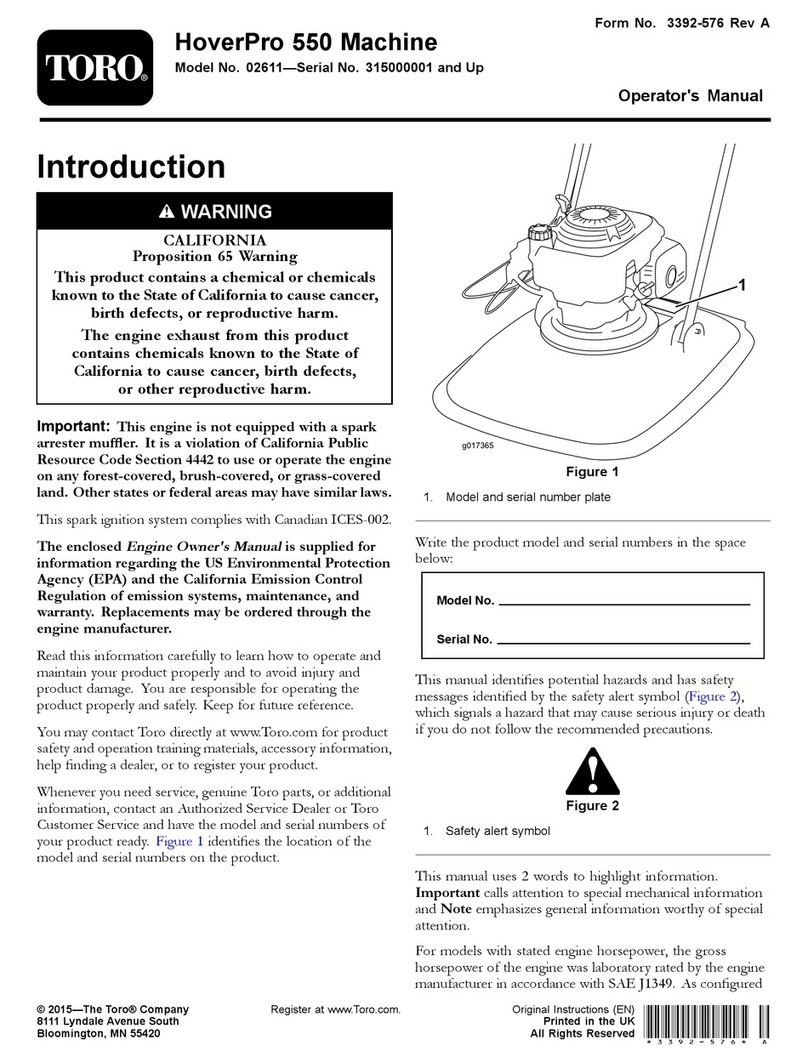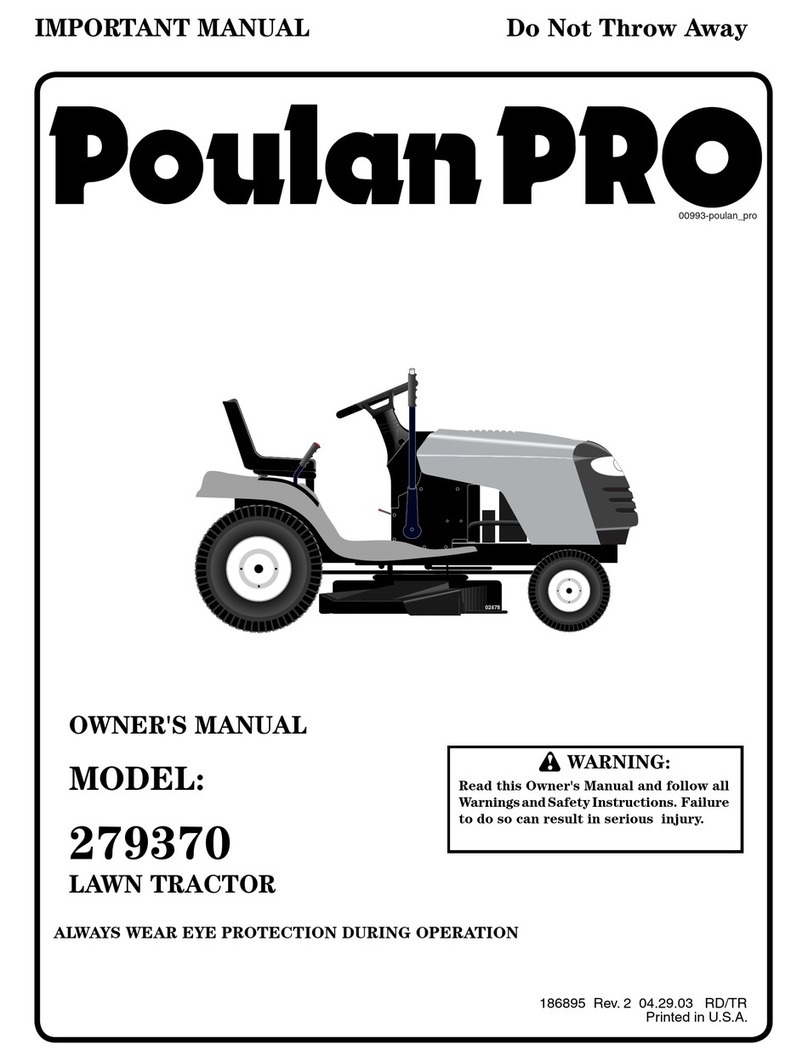Grasshopper 727T6 User manual

OPERATOR’S
MANUAL & PARTS LIST
RIDING MOWER
MODELS
723T & 727T6
THE GRASSHOPPER COMPANY
Moundridge, Kansas 67107 U.S.A.
Phone (620) 345-8621
Fax (620) 345-2301
Form 172217-090508
Printed in U.S.A.
Price $7.00

2
INTRODUCTION
Congratulations on your selection of Grasshop-
per equipment. We believe you have exercised
excellent judgment in the purchase of Grasshop-
per equipment. We are most appreciative of
your patronage.
We recommend that you carefully read this en-
tire manual before operating the unit. Time
spent becoming fully acquainted with its perfor-
mance features, adjustments and maintenance
will add a longer and more satisfactory life to
your Grasshopper.
The Grasshopper equipment you have pur-
chased has been carefully engineered and
manufactured to provide dependable and satis-
factory use. Like all mechanical products it will
require cleaning and upkeep. Lubricate it as
specified in the manual. Observe all safety infor-
mation in this manual and all safety decals on
the tractor and attachments.
The illustrations and data used in this manual
were current at the time of printing, but due to
possible in-line production changes your ma-
chine may vary slightly in detail. The
manufacturer reserves the right to make changes
or add improvements to its products at any time
without incurring any obligation to make such
changes to products manufactured previously.
As with all lawn and grounds equipment, if
handled carelessly this machine is a dangerous
piece of equipment. If used incorrectly this
machine can cause severe injury. You, the op-
erator, are responsible when operating it.
Therefore, safety is of the utmost importance.
ATTENTION:
• Read the instructions and warnings care-
fully before using this machine.
•Read your Grasshopper warranty enclosed
with the tractor manual. To validate war-
ranty, fill in the required information and
return the warranty form within 10 days of
purchase to:
THE GRASSHOPPER CO.
P.O. Box 637
Moundridge, Kansas 67107
Use only genuine Grasshopper service parts.
Substitute parts will void the warranty and may
not meet standards required for safe and satis-
factory operation. Record the model and serial
number of your mower.
MODEL:
SERIAL NUMBER:
(Serial tag is located under seat on tractor
frame by throttle.)
Provide this information to your dealer to obtain
correct repair parts.
The engine exhaust from this product
contains chemicals known to the State
of California to cause cancer, birth
defects or other reproductive harm.
WARNING
Copyright © 2008 & 2007 by The Grasshopper Company.
All rights reserved.

3
TABLE OF CONTENTS
PAGE
SPECIFICATIONS 5
SAFETY SYMBOLS 6
SAFETY DECALS 7
SAFETY INFORMATION
Training .................................................................................................................................... 8
Preparation ................................................................................................................................. 8
Fuel Handling Safety ................................................................................................................ 8-9
Operational Safety ................................................................................................................. 9-10
Maintenance Safety .................................................................................................................. 10
Storing Safely ........................................................................................................................... 10
GENERAL INFORMATION
General Information .................................................................................................................. 11
Measurement Conversion ......................................................................................................... 12
Bolt Size and Tightening Recommendations ............................................................................... 12
OPERATION
Controls and Switches .............................................................................................................. 13
Pre-start Check List ............................................................................................................ 13-14
Mounting and Dismounting the Tractor - with Mower Deck ....................................................... 14
Mounting and Dismounting the Tractor - with All Other Attachments .......................................... 14
Starting the Engine .................................................................................................................... 15
Cold Weather Starting Tips ....................................................................................................... 15
Uneven Terrain .................................................................................................................... 15-16
Stopping Engine ........................................................................................................................ 16
Moving Unit Without Power ..................................................................................................... 16
Steering Lever Operation ..................................................................................................... 17-18
LUBRICATION AND MAINTENANCE
Lubrication ............................................................................................................................... 19
Capacities ................................................................................................................................ 19
Tire Air Pressure ...................................................................................................................... 19
Drive System ............................................................................................................................ 19
Crankcase Oil and Air Filter ..................................................................................................... 19
Cooling System ........................................................................................................................ 19
Battery Maintenance ................................................................................................................. 20
Checking Drive System Fluid Level ........................................................................................... 20
Changing Drive System Fluid and Filters .................................................................................... 20
ADJUSTMENTS AND TROUBLESHOOTING
Loss of Power in the Drive System ............................................................................................ 21
No Positive Neutral Position ..................................................................................................... 21
Neutral Adjustment ................................................................................................................... 21
(continued)
Rev. 10-08

4
TABLE OF CONTENTS - (CONTINUED)
Parking Brake Adjustment ........................................................................................................ 21
Clutch Removal / Replacement ............................................................................................. 21-22
Clutch / Brake Burnishing .......................................................................................................... 22
Engine Troubleshooting ............................................................................................................. 22
Wiring Circuit Board Removal .................................................................................................. 22
Steering Lever Adjustment ........................................................................................................ 23
Foot Rest Block Installation ...................................................................................................... 23
TRACTION KIT INSTALLATION
Adjusting Traction Spring Tension ............................................................................................. 24
Removing Mower Deck From Traction Kit Equipped Tractor ................................................... 24
Rear Weight Requirements ........................................................................................................ 24
PARTS LIST AND ILLUSTRATION
Tractor Assembly 723T ....................................................................................................... 26-27
Tractor Assembly 727T6...................................................................................................... 28-29
Drive Assembly ................................................................................................................... 30-31
Brake Assembly .................................................................................................................. 32-33
ROPS & Seat Assembly ...................................................................................................... 34-35
PTO Shaft & Clutch Assembly ................................................................................................. 36
Steering Assembly .................................................................................................................... 37
Wiring Diagram ................................................................................................................... 38-39
Tail Wheel Options .............................................................................................................. 40-41
Traction Kit .............................................................................................................................. 42
Counterweight Mount Kit ......................................................................................................... 43
Limited Universal Harness (all Non-Hydraulic Lift Models) ........................................................ 44
Hydraulic Lift Wiring Assembly ................................................................................................. 45
Hydraulic Lift Assembly ....................................................................................................... 46-47
Standard Universal Harness (all Hydraulic Lift Models) ............................................................. 48
Rev. 01-08

5
SPECIFICATIONS
723T 727T6
Engine Kohler Command, two cylinder, Kohler Command, two cylinder,
4 cycle, air cooled 4 cycle, air cooled
Model No. CH23 CH740
Horsepower (G.I.H.P.) 23 (17.2 kw) 27 (20.2 kw)
Displacement 41 cu. in. (674 cc) 44 cu. in. (725cc)
No-load r.p.m. 3600 3600
Charging System 12VDC 15 amp. negative ground 12VDC 15 amp. negative ground
Starter Electric Electric
Electrical System Safety interlocked Safety interlocked
PTO 3100 r.p.m. (max) 3100 r.p.m. (max)
Electric clutch Electric clutch
Drive System Tandem hydrostatic T6hydrostatic transmission
transmission direct drive direct drive
Steering Dual levers independently control speed and direction of travel.
Zero turning radius (center of machine is pivot point)
Speed
Forward (variable) 0 to 9 mph (14.5 km/h) 0 to 10 mph (16.1 km/h)
Reverse (variable) 0 to 6 mph (9.6 km/h) 0 to 6 mph (9.6 km/h)
Fuel Tank Capacity 4.3 U.S. gal. (16.3 l) 8.0 U.S. gal. (30.2 l)
Tire Sizes
Front Drive Wheels
Standard 22 x 11 x 10 - 4 ply rated
Optional 22 x 10 x 10 - 4 ply rated
Tail Wheel 13 x 6.50 x 6 rib - 4 ply rated
Dimensions of Tractor
Seat Back Height 46" (1.17 m)
Seat Cushion Height 30.5" (.78 m)
Tractor Width 50" (1.26 m)
Tractor Length 79.5" (2.02 m)
Wheel Base 51.5" (1.31 m)
Weight - Uncrated 850 lbs (385.6 kg) 875 lbs (396.9 kg)
Weight - Crated 1020 lbs (462.7 kg) 1060 lbs (480.8 kg)
Hour Meter Standard
Rev. 01-08

6
SAFETY SYMBOLS
This Safety Alert Symbol means ATTENTION!
BECOME ALERT! YOUR SAFETY IS IN-
VOLVED!
Throughout this manual the term IMPORTANT
is used to indicate that failure to observe can cause
damage to equipment. The terms CAUTION,
WARNING and DANGER are used in con-
junction with the Safety Alert Symbol [a
triangle with an exclamation mark] to indicate
the degree of hazard for items of personal safety.
Is used for general reminders of good
safety practices or to direct attention
to unsafe practices.
Denotes a specific potential hazard.
Denotes the most serious specific
potential hazard.
CAUTION
WARNING
DANGER

7
SAFETY DECALS
Replace Immediately If Damaged
Fig. 1
07068
Part No. 165629
Part No. 165300
Part No. 165679
Part No. 165340
Part No. 165720
Part No. 165661
Part No. 165345
Part No. 165024
Part No. 165090
CAUTION
165024
TO AVOID SERIOUS INJURY,
READ MANUAL BEFORE OPERATING & FOLLOW ALL
SAFETY AND OPERATING INSTRUCTIONS.
KEEP FEET FORWARD ON FOOT REST TO AVOID
HEEL PINCHING.
BEFORE DISMOUNTING, STOP ENGINE & REMOVE KEY.
ALLOW NO RIDERS.
AVOID OPERATING NEAR DROP-OFFS, EMBANKMENTS,
AND HOLES.
*
*
*
*
*
CAUTION
FAN BLADE
165345
KEEP HANDS CLEAR
FAN CAN CAUSE PERSONAL INJURY
WARNING
TO AVOID SERIOUS INJURY OR DEATH
165661
DO NOT OPERATE ON STEEP SLOPES:
SEE OPERATOR'S MANUAL FOR DETAILS.
NEVER OPERATE WITHOUT ROPS DEPLOYED.
WEAR SEATBELT WHEN ROPS IS DEPLOYED.
OPERATE CONTROLS SMOOTHLY AND
SLOWLY, ESPECIALLY ON SLOPES.
MACHINE MAY ROLL ON SLOPES WHEN
NOT UNDER POWER. ALWAYS SET PARK
BRAKE.
DO NOT OPERATE WHEN ATTACHMENT
IS REMOVED.
•
•
•
•
•
•
WARNING
165340
DO NOT ALTER ELECTRICAL SYSTEM.
WRONG WIRING CONNECTIONS WILL DAMAGE
ELECTRICAL COMPONENTS AND MAY MAKE
THE SAFETY SWITCHES INOPERATIVE.
WARNING
THE ENGINE EXHAUST FROM THIS
PRODUCT CONTAINS CHEMICALS KNOWN
TO THE STATE OF CALIFORNIA TO
CAUSE CANCER, BIRTH DEFECTS OR
OTHER REPROCUCTIVE HARM
165300
WARNING
ROPS AND
SEATBELT
WERE
SUPPLIED
WITH THIS
MACHINE &
MUST BE
INSTALLED
BEFORE
OPERATION.
165090
WARNING
165629
ROTATING SCREEN AND
SHAFT. DO NOT CLEAN
OR SERVICE WHILE
ENGINE IS RUNNING.
CAUTION
165720
SHUT OFF ENGINE BEFORE REFUELING.
NEVER FILL FUEL TANK INDOORS OR
WHEN ENGINE IS HOT.
WIPE UP ALL SPILLED GASOLINE BEFORE
STARTING ENGINE.
DO NOT SMOKE WHILE REFUELING.

8
WORK SAFELY - FOLLOW THESE RULES
CAUTION
Rev. 10-08
The designed and tested safety of this
equipment depends on it being
operated within the limitations as
explained in this manual. Read manual
before operating.
TRAINING
•Safety instructions are important! READ
THIS MANUAL AND ALL SAFETY
RULES.
•Know your equipment’s controls and how to
stop tractor, engine and attachments quickly
in an emergency.
•To avoid accident or injury, do not allow any-
one to operate this equipment without proper
instruction. Any person who operates this
equipment MUST be instructed in and ca-
pable of the safe operation of the unit, its
attachments and all controls.
•Do not allow children or unqualified individu-
als to operate equipment.
PREPARATION
•Always wear relatively tight and belted cloth-
ing to avoid entanglement in moving parts.
Wear sturdy, rough soled work shoes. Never
operate tractor or implements in bare feet,
sandals or sneakers.
•This machine produces sound levels in excess
of 85 dBA at the operator ear and can cause
hearing loss through extended periods of ex-
posure. Wear hearing protection when
operating this machine.
•Ensure attachments are properly mounted,
adjusted and in good operating condition.
•Make sure driveline spring-activated locking
collar slides freely and is seated firmly in the
tractor PTO groove.
• Check brake action before you operate. Ad-
just or service brakes as necessary.
• Ensure all safety switches function properly.
See Operation section for details.
•Remove accumulated debris from attachment
and tractor to avoid fire hazard.
•Ensure all safety shielding is in good condition
and properly installed.
•Ensure either the discharge shield, restriction
plate, or complete vacuum attachment is in-
stalled.
•Ensure all safety decals are installed and in
good condition.
•Use correct counterweights when certain at-
tachments are installed (see specific
accessory installation instructions).
•Inspect area to be cut removing stones,
branches and other debris that might be
thrown causing injury or damage.
• Evaluate the terrain to determine what acces-
sories and attachments are needed to
properly and safely perform the job.
• Low-hanging branches and similar obstacles
can injure the operator or interfere with mow-
ing operation. Before mowing, identify
potential obstacles such as low-hanging
branches, and trim or remove those ob-
stacles.
•Never permit any person, other than the op-
erator, to ride or board the tractor or
implements at any time.
•Operate only in daylight or good artificial
light.
FUEL HANDLING SAFETY
•In certain conditions, gasoline, ethanol, diesel
and other types of fuel are extremely flammable
and highly explosive. A fire or explosion from
fuel can burn you and others and can damage
property.
•Fill the fuel tank outdoors, in an open area,
when the engine is cold. Wipe up any fuel that
spills.
•Do not remove the fuel cap if the engine or
fuel tank is hot. Allow several minutes to
cool.
•Remove the fuel cap slowly to release any
pressure from the fuel tank.
•Do not fill the fuel tank completely full. Add fuel
to the tank until the level is 6 mm to 13 mm be-
low the bottom of the filler neck. This empty
space in the tank allows fuel to expand.
• Never smoke when handling fuel, and stay
away from an open flame or where fuel fumes
may be ignited by a spark.
• Store fuel in an approved container and keep it

9Rev. 10-08
out of the reach of children. Never buy more
than a 30-day supply of fuel.
• Always place fuel containers on the ground
away from your vehicle before filling.
• Do not fill fuel containers inside a vehicle or on a
truck or trailer bed because interior carpets or
plastic truck bed liners may insulate the con-
tainer and slow the loss of any static charge.
•When practical, remove equipment from the
truck or trailer and refuel the equipment with its
wheels on the ground.
• If this is not possible, then refuel such equipment
on a truck or trailer from a portable container,
rather than from a fuel dispenser nozzle.
• If a fuel dispenser nozzle must be used, keep the
nozzle in contact with the rim of the fuel tank or
container opening at all times until fueling is
complete.
• Never use cellular phones or other portable
electronic devices when handling fuel.
OPERATIONAL SAFETY
•Read “Operation” section of this manual be-
fore attempting to operate this unit.
• Do not operate without ROPS deployed.
•Fenders serve as shields. Do not operate
without them.
•Keep bystanders away from equipment while
it is in operation.
•Keep children and pets a safe distance away.
Never direct discharge toward anyone.
•Start engine from operator’s seat after disen-
gaging tractor power takeoff and placing
steering levers into the neutral swing-out po-
sition.
•Keep hands and feet away from underneath
mower while engine is running. Stay clear of
all moving parts on tractor and attachments.
•Wear suitable hearing protection when oper-
ating this machine.
•Never allow anyone behind tractor or in front
of implements when operating.
•Do not operate in reverse unless absolutely
necessary and then only after careful obser-
vation of the entire area behind you.
•If operator must dismount to make adjust-
ments the engine must not be running.
• If machine is equipped with a fixed ROPS, al-
ways wear seatbelt.
• If machine is equipped with a foldable ROPS,
always wear seatbelt when ROPS is de-
ployed.
• When foldable ROPS must be down (i.e. load-
ing or unloading on an enclosed trailer), DO
NOT use seatbelt and drive with extra care.
• Do not move steering levers from forward to
reverse or reverse to forward position rap-
idly. The sudden change could cause loss of
control and/or damage to equipment.
•Do not operate on steep slopes.
•Do not stop, start or change directions sud-
denly on slopes.
•Use extreme care and maintain minimum
ground speed when traveling or operating on
a hillside, over rough ground, or when oper-
ating close to ditches and fences.
•Reduce speed on slopes and sharp turns to
minimize tipping and avoid loss of control. Be
careful when changing directions on slopes.
•Stay alert for holes, rocks, roots and other
hidden hazards in the terrain. Keep away
from drop-offs.
•Stop mower or other attachment and tractor
immediately upon striking an obstruction.
Turn engine off, inspect attachment and trac-
tor. Repair any damage before resuming
operation.
•Disengage power to attachment, stop engine,
remove key and wait for all movement to stop
before dismounting, making adjustments,
cleaning, or unclogging the machine.
•Never transport attachments with PTO running.
•Watch for traffic when operating near or
crossing roadways.
•This unit is not equipped for highway use, es-
pecially when safety lighting and marking is
required. It is not a recreational vehicle.
•This unit is not equipped with a drawbar. Do
not pull loads.
• Take all possible precautions when leaving
tractor unattended: disengage PTO, lower at-
tachment, place controls in neutral, set
parking brake, stop engine and remove key
from ignition.
•Move very slowly when attachment is re-
moved. Never carry passengers.

10 Rev. 10-08
•Do not run engine in an enclosed area without
adequate ventilation. Exhaust gases contain
carbon monoxide, an odorless and deadly
poison.
MAINTENANCE SAFETY
•Always perform maintenance with the machine
parked on a hard level surface; with the engine
stopped and the PTO disengaged; with the park
brake set; and with the key removed from the
ignition.
•Always remove the grounded (-) clamp from
the battery when performing maintenance on the
engine, clutch, or any other electrical system.
•Never work under the machine without jack
stands or other equivalent safety blocks. Do
NOT rely solely on mechanical or hydraulic
jacks or lifts for support. Always use ad-
equate wheel chocks on tires remaining on
the ground.
• Hydraulic hoses can fail due to physical dam-
age, kinks, age, and exposure. Check hoses
regularly. Replace damaged hoses.
•Escaping fluid under pressure can penetrate
the skin causing serious injury. Avoid the
hazard by relieving pressure before discon-
necting hydraulic or other lines. Tighten all
connections before applying pressure. If an
accident occurs, see a doctor immediately.
Any fluid injected into the skin must be surgi-
cally removed within a few hours or gangrene
may result.
• Search for leaks with a piece of cardboard.
Protect hands and body from high pressure
fluids.
• If it is necessary to run an engine in an en-
closed area, remove the exhaust fumes from
the area with an exhaust pipe extension. If an
exhaust pipe extension is not available, work
near open doors and get outside air into the
area.
•Waste products such as used oil, fuel, cool-
ant, and batteries can harm the environment
and people. Dispose of waste products
properly.
•Never attempt to disconnect or alter any part
of the safety interlock systems.
•Keep engine free of grass, leaves, or excess
grease to reduce fire hazard and minimize en-
gine overheating.
•Do not change engine governor settings.
•Keep tractor and attachments in good oper-
ating condition and all safety devices in place.
•Periodically tighten all bolts, nuts and screws.
Check that all cotter pins are properly in-
stalled to ensure equipment is in a safe
condition.
• Check brake operation frequently. Adjust
and service as required.
STORING SAFELY
•Never store equipment with fuel in the tank
inside a building where fumes may reach an
open flame, spark or pilot light as on a fur-
nace, water heater, clothes dryer, or other
gas appliance. Allow engine to cool before
storing in an enclosure.
•If engine is to be unused for 30 days or more,
add a fuel stabilizer to the fuel system. Fuel
stabilizer (such as STA.BIL®) is an accept-
able additive in minimizing the formation of
fuel gum deposits during storage. Add stabi-
lizer to fuel in fuel tank or storage container.
Always follow mix ratio found on stabilizer
container. Run engine at least 10 minutes af-
ter adding stabilizer to allow it to reach the
carburetor or injectors.
•If draining fuel tank, drain fuel into an ap-
proved container outdoors and away from
open flame.
•Always provide adequate ventilation when
running engine indoors. Exhaust gases contain
carbon monoxide, an odorless and deadly
poison.
•Remove attachments from tractor. Remove
all accumulated debris from attachments and
tractor.
• Sand areas where paint is chipped and re-
paint to prevent rust. Lubricate all locations
to prevent moisture damage during storage.

11
GENERAL INFORMATION
The purpose of this manual is to assist the operator
in maintaining and operating GRASSHOPPER
tractors. Read it carefully. It furnishes informa-
tion and instructions that will help you achieve
years of dependable performance.
These operating and maintenance instructions
have been compiled from extensive field experi-
ence and engineering data. Some information
may be general in nature due to unknown and
varying conditions. However, through experi-
ence and these instructions you should be able to
develop operating procedures suitable to your
particular situation.
The illustrations and data used in this manual
were current at the time of printing, but due to
possible in-line production changes your ma-
chine may vary slightly in detail.
GRASSHOPPER reserves the right to redesign
and change the machine as necessary without
notification.
Some illustrations in this manual show
the equipment with safety shields
removed to provide a better view. The
mower should never be operated with
any safety shielding removed.
WARNING
Fig. 2
Throughout this manual, references are made to
right and left directions. These are determined
by standing at the rear of the equipment and fac-
ing the direction of forward travel.
Mower blade rotation is clockwise as viewed
from the top of mower.
07068
LEFT RIGHT

12
Bolt Head Markings
SAE Grade 2
(no dashes)
SAE Grade 5
(3 radial dashes)
SAE Grade 8
(6 radial dashes)
MEASUREMENT CONVERSION
Measurements expressed in this manual are
decimal values. Use the chart below if you are
unsure of a measurement to obtain the fractional
equivalent.
BOLT SIZE AND TIGHTENING
RECOMMENDATIONS
The chart below lists the correct tightening
torque for bolts used on Grasshopper equip-
ment. When bolts are to be tightened or replaced
refer to this chart to determine the grade of bolt
and proper torque (except when specific torque
values are assigned in the manual text).
Recommended Torque in Foot Pounds
FractionDecimal SAE Grade 2 SAE Grade 5 SAE Grade 8
Bolt Diameter in Inches
0.250
0.312
0.375
0.437
0.500
0.562
0.625
0.750
0.875
1.000
1/4
5/16
3/8
7/16
1/2
9/16
5/8
3/4
7/8
1
6
13
23
37
57
82
111
200
280
350
11
21
38
55
85
125
175
300
450
680
14
25
55
80
120
180
230
440
720
1035
Decimal
Conversion Table - Inches
Decimal Fraction
0.062
0.125
0.187
0.250
0.312
0.375
0.437
0.500
1/16
1/8
3/16
1/4
5/16
3/8
7/16
1/2
0.562
0.625
0.687
0.750
0.812
0.875
0.937
1.000
9/16
5/8
11/16
3/4
13/16
7/8
15/16
1
Fraction

13
OPERATION
The safe operation of this machine is the responsibil-
ity of the operator. The operator should be familiar
with the tractor and all attachments that will be used
before starting operation. Read all safety informa-
tion on pages 6 through 10.
CONTROLS AND SWITCHES
Know your controls and how to stop tractor, en-
gine and attachments quickly in an emergency.
•Stop tractor by moving steering levers to
neutral position (refer to section on steering
lever operation, page 17-18).
•Stop engine by turning key to “OFF”
position.
•Disengage power to attachments by moving
PTO switch to “OFF” (down) position.
Operating this unit is not difficult once you mas-
ter the use of the controls. We recommend you
equip the tractor with the attachment you will be
using and practice in a flat open area at a me-
dium throttle setting until you are comfortable
with the controls.
Before operating this machine be sure
the operator-presence safety system
works. Do not run the engine without
an operator in the seat if the PTO
switch is “ON” or either steering lever
is in the run position.
Several safety switches are incorporated in the
unit’s design to prevent it from being started out
of neutral or with the PTO engaged. All controls
must be in the “OFF” or neutral position before
the unit can be started. There is a safety switch
under the operator’s seat that will cause the en-
gine to stop, should the operator leave the seat
with any control engaged.
PRE-START CHECK LIST
•Place tractor on level surface.
•Check crankcase oil level (refer to “Engine
Manual” for proper level and type of oil used).
Never attempt to check oil while engine
is running.
•Clean rotating air intake screen. When mow-
ing in dusty conditions, dry grass or long
grass it may be necessary to frequently clean
rotating air intake screen to prevent engine
overheating.
Never attempt to clean rotating air
intake screen while engine is running.
•Check for grass wrapped around PTO shaft.
When mowing long grass, turn off key and
check for grass wrapped around PTO shaft
every 30 minutes of operation.
Remove spark plug wire to prevent
accidentally starting engine before
attempting to remove grass from
around PTO shaft.
•Check air cleaner (refer to “Engine
Manual”). When mowing in dusty condi-
tions, dry grass or long grass it may be
necessary to frequently clean the air
cleaner.
•Check to be sure engine is free of dirt and debris.
•Check fuel level. Refer to “Engine Manual”
for correct fuel for your requirements.
Do not fill fuel tank while engine is
running. Allow engine to cool two
minutes before refueling. If fuel is
spilled, do not start engine and avoid
creating any source of ignition until
the fuel has evaporated.
•Check tire pressure (see page 19). Improper
pressure will adversely affect traction, steer-
ing and level cutting height.
•Check that cooling fins on the transmissions
are clean.
CAUTION
WARNING
WARNING
DANGER
WARNING

14
MOUNTING AND DISMOUNTING
THE TRACTOR - WITH MOWER
DECK
Always mount and dismount the mower from the
left side, with the brake on, the PTO disengaged
(down), the engine off, and the steering levers in
their swung out (neutral lock) position. Mount
the mower by stepping from the ground to the left
side of the deck with your left foot, then step over
the deck frame to the footrest with your right
foot. Anti-skid material is provided on the top of
the deck and footrest. Always keep these sur-
faces clean and dry. Replace anti-skid material
when necessary. Wait for all moving parts to
stop before dismounting. Dismount the mower
by standing up on the footrest, then turn to the left
and step from the footrest, over the deck frame,
to the left side of the deck with your right foot,
and then step to the ground with your left foot.
The left steering lever can be used to stabilize
your movement; however, it is not strong enough
to support all your weight. Never leave the
mower unattended with the key in the ignition.
Action
Left
Steering
Lever
Right
Steering
Lever PTO
Switch
Parking
Brake
Proper
Result
Start Circuits
Kill Circuits (with engine running at 1/2 throttle)
Test Safety Interlock System Daily
Try starting engine
Try starting engine
Try starting engine
Try starting engine
Raise off seat
Raise off seat
Raise off seat
Raise off seat
Move left steering
lever in
Out
Out
Out
Out
Out
Out
Out
Out
Out
Out
Out
Out
Out
Out
In
In
In
In
Off
Off
Off
Off
Off
Off
Off
Off
Off
Off
On
On
On
On
On
On
On
On
On
On
Engines Cranks
Engine will not crank
Engine will not crank
Engine will not crank
Engine does not stop
Engine Stops
Engine Stops
Engine Stops
Engine Stops
Engine Stops
Move right steering
lever in
MOUNTING AND DISMOUNTING
THE TRACTOR - WITH ALL
OTHER ATTACHMENTS
Always mount and dismount the mower from the left
side, with the brake on, the PTO disengaged
(down), the engine off, and the steering levers in
their swung out (neutral lock) position. Mount the
mower by stepping from the ground to the footrest
with your right foot. Anti-skid material is provided
on the top of the footrest. Always keep these sur-
faces clean and dry. Replace anti-skid material
when necessary. Wait for all moving parts to stop
before dismounting. Dismount the mower by stand-
ing up on the footrest, then turn to the left, and step
from the footrest to the ground with your right foot.
The left steering lever can be used to stabilize your
movement; however, it is not strong enough to sup-
port all your weight. Never leave the mower
unattended with the key in the ignition.
Rev. 01-08

15
DANGER
STARTING THE ENGINE
Never start the engine in confined
rooms. Exhaust gases contain carbon
monoxide, an odorless and deadly
poison.
Do not allow children to approach the
machine while the engine is running.
Do not operate the machine around
open flames, i.e., trash fires.
Do not operate the engine when an
odor of fuel is present or other
explosive conditions exist.
•Position yourself on the tractor seat.
•Place both steering levers in swing-out neu-
tral position.
•Place electric clutch switch in “OFF”
(down) position.
•Set the throttle at 1/3open.
•Insert the key into the ignition switch and turn
to “RUN” position.
•Check to see that the oil lamp is on.
•Turn the key to “START” position. Choke as
necessary to start. When engine starts release
key immediately. Push choke in gradually un-
til choke is completely in and engine is running
smoothly.
•Check to see that the oil lamp is off. If the
lamp remains lit a problem exists in that sys-
tem.
•Warm the engine up at medium speed for
several minutes.
You will enhance the starter life by using short
starting cycles of several seconds. Engaging
starter motor more than 15 seconds per minute
can result in damage to starter.
COLD WEATHER STARTING TIPS
Use proper viscosity oil for temperature expected
(see “Engine Manual”).
Set throttle at half open.
A warm battery has better starting capacity than
a cold one.
Use fresh winter grade fuel. It is better for winter
starting than leftover summer grade fuel.
UNEVEN TERRAIN
Be careful when operating machine on
uneven ground.
Do not operate on steep slopes.
Operation on a steep slope could cause
loss of control, machine to overturn and
personal injury or death.
nn
nn
nDo not operate on steep slopes. This ma-
chine was not specifically designed to
operate on steep slopes.
nn
nn
nThe operator is responsible for safe opera-
tion on slopes. Only the operator can
determine the stability of the machine on a
given slope based on existing conditions
like: machine speed and direction, slope
variation, slipperiness, drop-offs, holes,
obstacles, etc.
nn
nn
nTo determine stability on a slope, start at
the bottom and try to drive the machine up
the slope slowly. If you cannot drive up
the slope or if you feel uneasy on it, do not
operate on it.
nn
nn
nAlways start mowing at the bottom of
slopes. Traveling up slopes, this machine
has more traction traveling in reverse than
forward. Be careful on slopes to avoid
driving into a position where there is not
enough traction to enable driving out or
WARNING
WARNING

16
STOPPING THE ENGINE
•Set the throttle at idle. Allow engine to idle
for several minutes.
•Move ignition switch to “OFF” position and
remove key.
•Never use the carburetor choke to stop en-
gine.
• Turn engine off at half throttle to prevent "run-
on" when engine is hot.
Always remove key from ignition
switch when leaving unit unattended
or when not in use.
MOVING UNIT WITHOUT POWER
The tandem hydro pump is equipped with bypass
valves that allow the unit to be moved without
power by deactivating the pump. With the bypass
valves in normal operating position, the fluid in the
pump will make it difficult to move the unit (even
with the steering levers in neutral position). The by-
pass valves are located on the right side of the
pump. Activate each bypass valve by rotating one
revolution counter-clockwise with a .625 inch
socket. When BOTH bypass valves are activated
the unit becomes “freewheeling”, allowing it to be
moved. Before the hydro pump becomes opera-
tional, the bypass valves must be returned to their
normal operating position. Do not tighten above
120 in lbs (10 ft lbs) maximum.
Fig. 3
CAUTION
LEFT BYPASS VALVE
RIGHT BYPASS VALVE
06080
stopping.
nn
nn
nTires may lose traction on slopes even
though the brakes are functioning properly.
nn
nn
nAvoid sudden stops and deceleration when
traveling forward downhill as mower may
tip forwards.
nn
nn
nDo not mow slopes when grass is wet be-
cause slippery conditions will reduce
traction and braking which in turn affects
steering.
nn
nn
nUse caution when making turns. Slow the
mower down before making sharp turns.
Unit can spin very rapidly by positioning
one lever too much ahead or behind the
other.
nn
nn
nLook around you to be sure the area is
clear before turning or backing up.
nn
nn
nAvoid starting or stopping on a slope. If
tires lose traction, disengage the blades
and proceed slowly straight down the
slope.
nn
nn
nKeep all movement on slopes slow and
gradual. Do not make sudden changes in
speed or direction.
nn
nn
nPass diagonally through sharp dips and
avoid sharp drops.
nn
nn
nFollow manufacturer’s recommendation
for counterweights for added stability
when operating on slopes or using front or
rear mounted attachments. Remove
weights when not required.
nn
nn
nUse extra care with grass catchers or other
attachments. These can change the stabil-
ity of the machine. Do not use grass
catcher on steep slopes.
nn
nn
nDo not operate without ROPS deployed.
nn
nn
nIf machine is equipped with a fixed ROPS, al-
ways wear seatbelt.
nn
nn
nIf machine is equipped with a foldable ROPS,
always wear seatbelt when ROPS is de-
ployed.
nn
nn
nBe certain that the seatbelt can be released
quickly if the machine is driven or rolls into
ponds or water.
nn
nn
nCheck carefully for overhead clearances
such as, branches, doorways, or electrical
wires, before driving under any objects
and do not contact them.

17
STEERING LEVER OPERATION
(refer to Fig. 4)
Do not move steering levers from
forward to reverse or reverse to
forward position rapidly. The sudden
change could cause loss of control or
damage to equipment.
The Grasshopper tractor is very
unstable without an attachment.
Move very slowly when attachment is
removed. Never carry passengers.
Steering levers control speed and direction of
movement. Pushing the levers forward will
move the tractor forward. Pulling levers to the
rear will move tractor in reverse. The further for-
ward or rearward the steering levers are moved,
the faster the machine will move.
At half throttle move both steering levers from
swing-out neutral inward. Move both steering
levers forward. To turn right, advance left lever
further forward than right lever. To turn left, ad-
vance right lever further forward than left lever.
If you leave one steering lever in neutral and ad-
vance the other lever, the tractor will turn a
complete circle. Move the levers to the rear and
practice turning and maneuvering in reverse.
Once you learn how the controls operate, prac-
tice until you become proficient and are
comfortable with the unit before you begin opera-
tion with an attachment.
If you become confused during
operation release both steering levers,
they will automatically return to the
centered neutral position and the
tractor will stop.
WARNING
IMPORTANT

18
93052A
FORWARD REVERSE
GENTLE
LEFT
SHARP
LEFT
SHARP
RIGHT
GENTLE
RIGHT
STEERING LEVER OPERATION
Fig. 4

19
LUBRICATION AND MAINTENANCE
CAPACITIES
Fuel Tank 723T ................... 4.3 U.S. gal. (16.3 l)
Fuel Tank 727T6................ 8.0 U.S. gal. (30.2 l)
Drive System .......................... 2.7 U.S. qt. (2.6 l)
Drive System Fluid Change
approx ...................... 2.2 U.S. qt. (2.08 l)
Optional Hydraulic Lift Capacity and
Fluid Change ............... 0.9 U.S. qt (.85 l)
TIRE AIR PRESSURE
Drive Tires
Standard 22 x 11 x 10 ............... 8 psi (55 kPa)
Optional 22 x 10 x 10 ................ 8 psi (55 kPa)
(refer to decal on wheel for correct tire air pres-
sure)
Rear Tires ............... 12 to 15 psi (83 to 103 kPa)
DRIVE SYSTEM
Fluid Change ...................................... 500 hours
Filter Change ...................................... 500 hours
CRANKCASE OIL AND AIR FILTER
Refer to the “Engine Manual” for the time table
for changing or service.
COOLING SYSTEM
Inspect the engine cooling fins periodically for
buildup of grass and debris. Buildup on the cool-
ing fins will cause the engine to overheat.
Removal of engine cowling may be required to
clean the fins, especially if cleaned infrequently.
Do not use high pressure water or
steam to clean the engine or drive
compartment. Water and cleaning
detergent may damage electrical
components and terminals, possibly
leading to component and safety
circuit failure.
Use a vacuum cleaner or air blower to remove
foreign material from the engine and drive compart-
ment.
CAUTION
WARNING
CAUTION
Always wear safety glasses and ear
protection when performing any
maintenance function that could
cause injury to eyes or ears.
Read all safety information on pages 6 through 10.
Lower attachment to ground, shut off
tractor engine, remove key and wires
to spark plugs before performing any
maintenance.
LUBRICATION
Do not let excess grease collect on or around parts,
particularly when operating in sandy areas.
The chart gives the frequency of lubrication in
operating hours based on normal operating con-
ditions. Severe or unusual conditions may require
more frequent lubrication.
Use an SAE multipurpose type grease for all lo-
cations shown. Be sure to clean fitting thoroughly
before using grease gun.
For Drive System, use Hydro-Max Fluid, part no.
345050 for 1 quart (.94 l) container or part no.
345055 for 1 gallon (3.76 l) container.
Lubricate Every Lubricate Every
8 Hours of Usage 80 Hours of Usage
Rear Wheel Bearings Clutch Power Shaft
(one fitting) (two fittings)
Universal Half Shaft
(one fitting)
Rev. 08-08

20
BATTERY MAINTENANCE
Follow the procedure below for battery mainte-
nance.
•Clean battery.
•Inspect cables for loose connection.
•Clean terminals.
•Inspect battery tray and hold-down.
•Inspect battery case for cracks or leaks.
Batteries contain sulfuric acid. Avoid
contact with skin, eyes, and clothing.
Batteries produce a highly explosive
hydrogen gas while being charged.
Always keep cigarettes, sparks, open
flame, and other sources of ignition
away from battery. Always shield
eyes and face from battery. In the
event of accident, flush with water and
call a physician immediately. Keep
batteries and acid out of the reach of
children.
CHECKING DRIVE SYSTEM FLUID
LEVEL
Check fluid level with the engine turned off. The
expansion tank is located on the right side under the
seat. To check the fluid level, place unit on level
surface and look through the side of the expansion
tank. The fluid level should be equal to the full mark
on the reservoir decal (Refer to Fig. 5). If fluid is
required, make certain that expansion tank plug and
the area around it is clean and free of any foreign
matter before adding fluid. Use Hydro-Max Fluid
(Grasshopper part number 345050 for 1 quart [.94
l] container).
CHANGING DRIVE SYSTEM FLUID
AND FILTER
(Refer to illustration page 31)
Change fluid and filter every 500 hours. To drain
fluid, remove drain plug from the bottom of tandem
hydro pump. Allow fluid to drain completely. Rein-
stall plug and tighten.
To replace filter (item 3), which is located in the bot-
tom of tandem hydro pump, make certain that the
area around filter is clean and free of any foreign
matter. Remove the filter and replace with a new fil-
ter (Grasshopper part number 130505).
To refill the system with fluid, make certain that the
area around the expansion tank adapter (item 70) is
clean and free of any foreign matter. Disconnect the
hose (item 64) from the adapter and remove
adapter from tandem hydro pump. Refill the pump
with Hydro-Max Fluid (Grasshopper part number
345050 for 1 quart [.94 l] container). Reinstall
adapter in pump and reconnect hose to adapter.
Refill expansion tank with Hydro-Max Fluid to the
proper level (Refer to Fig. 5). Run engine and
check that fluid level in expansion tank is at the
proper level.
Note: No air bleeding is necessary since the
system is self-bleeding.
WARNING
Fig. 5
This manual suits for next models
1
Table of contents
Other Grasshopper Lawn Mower manuals
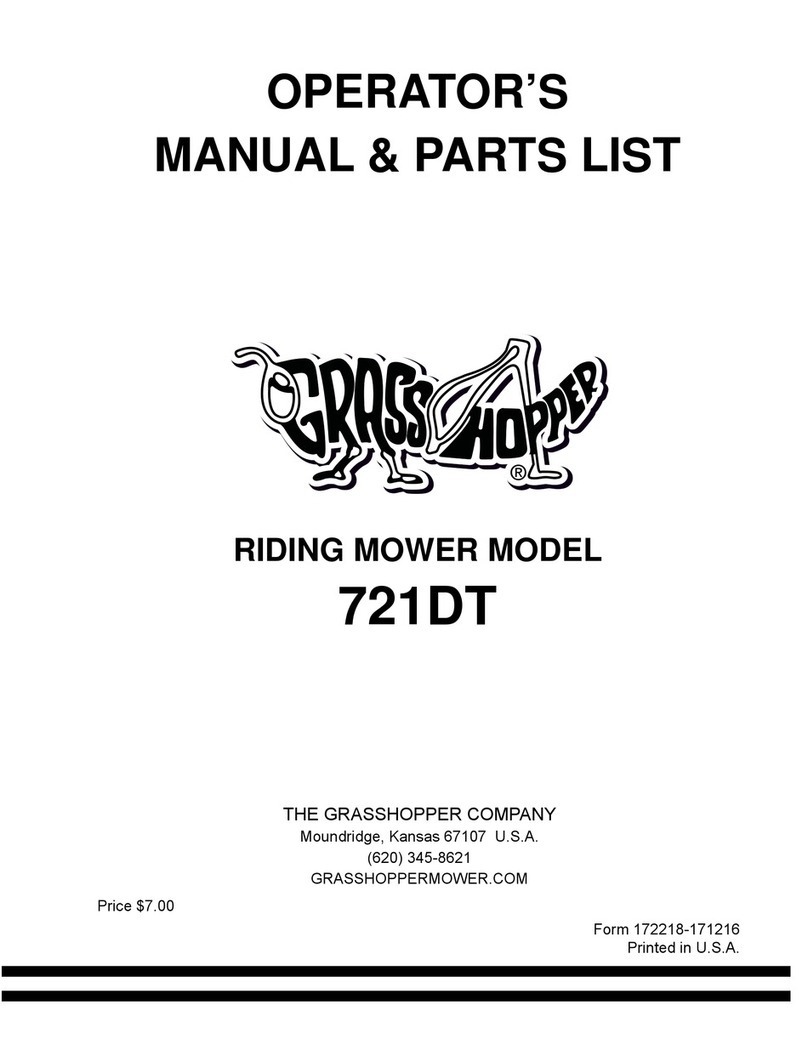
Grasshopper
Grasshopper 721DT Installation and operation manual
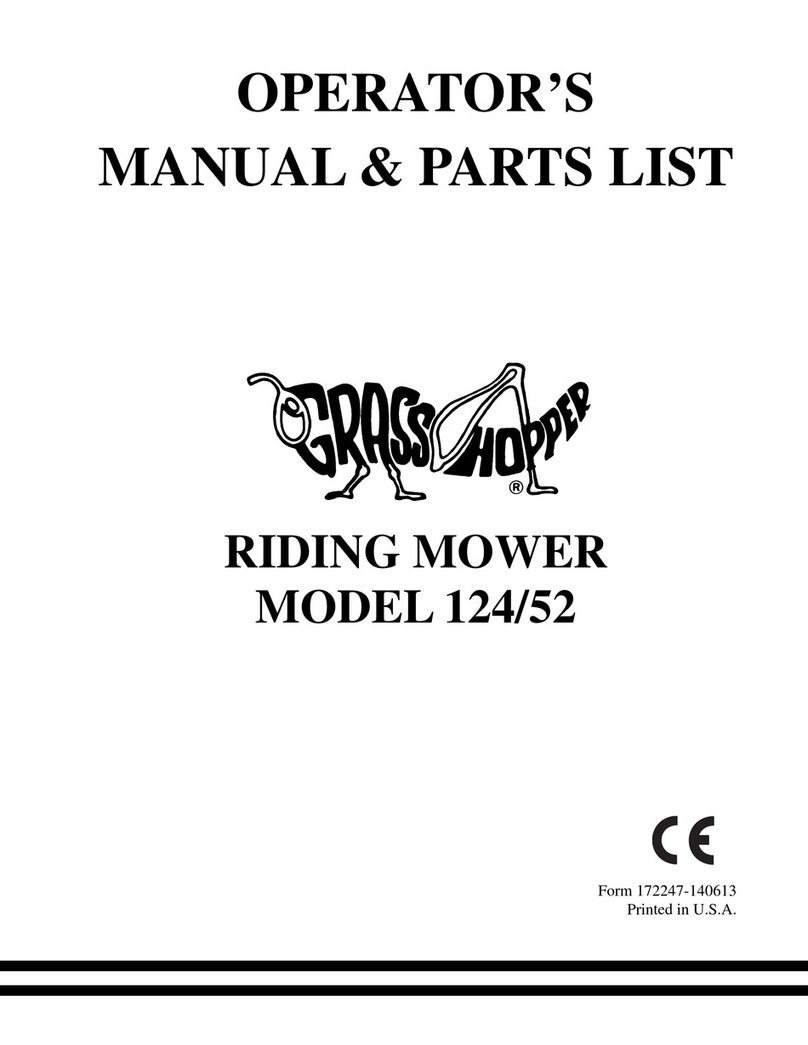
Grasshopper
Grasshopper 124/52 Installation and maintenance instructions

Grasshopper
Grasshopper 124V/48 User manual
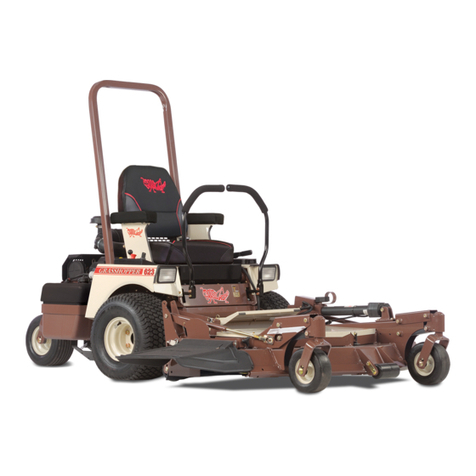
Grasshopper
Grasshopper 623T Installation and operation manual
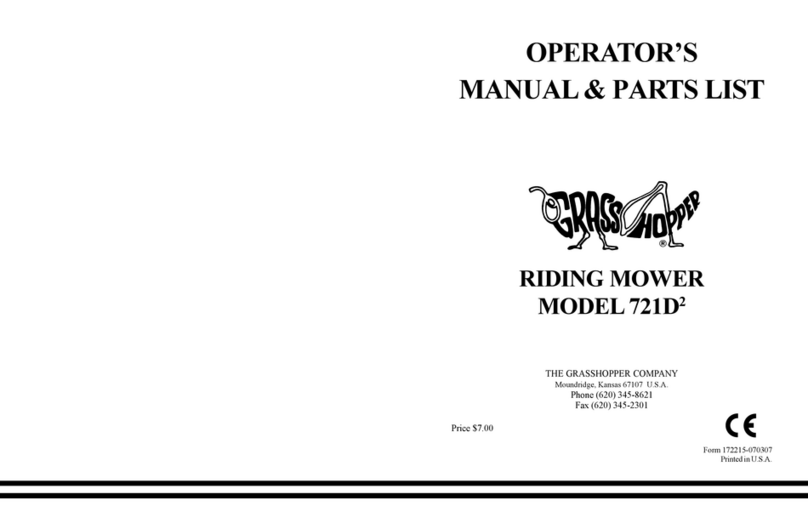
Grasshopper
Grasshopper 721D2 Installation and operation manual
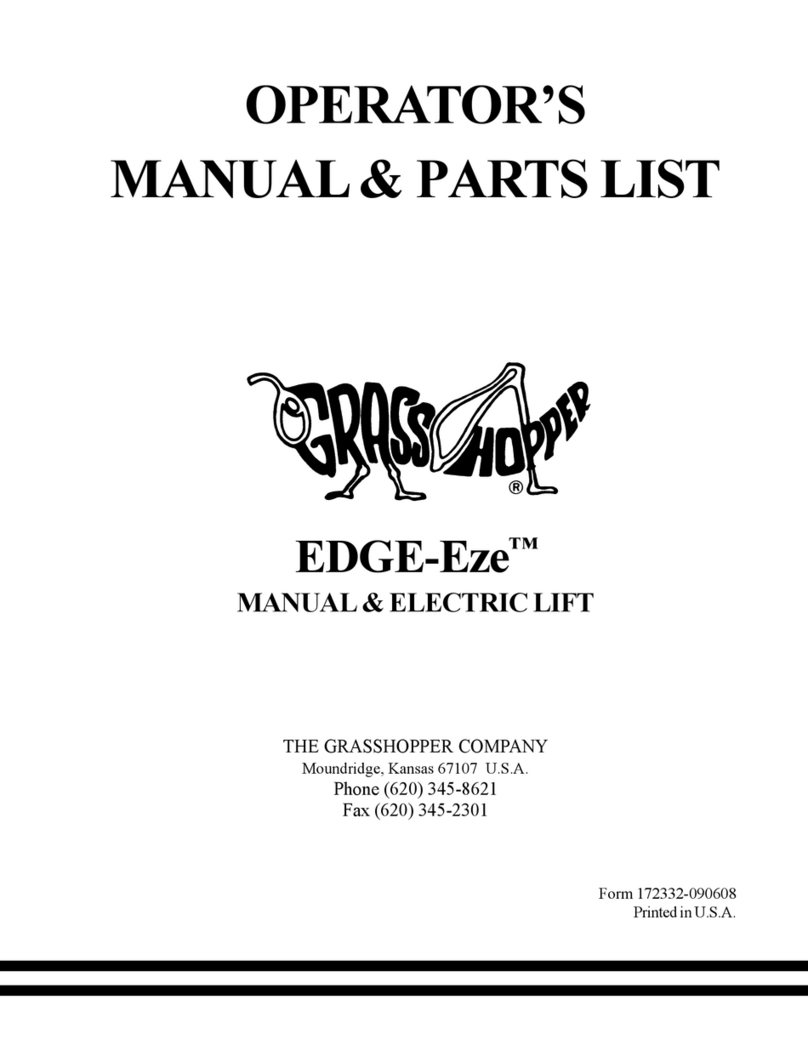
Grasshopper
Grasshopper EDGE-Eze User manual
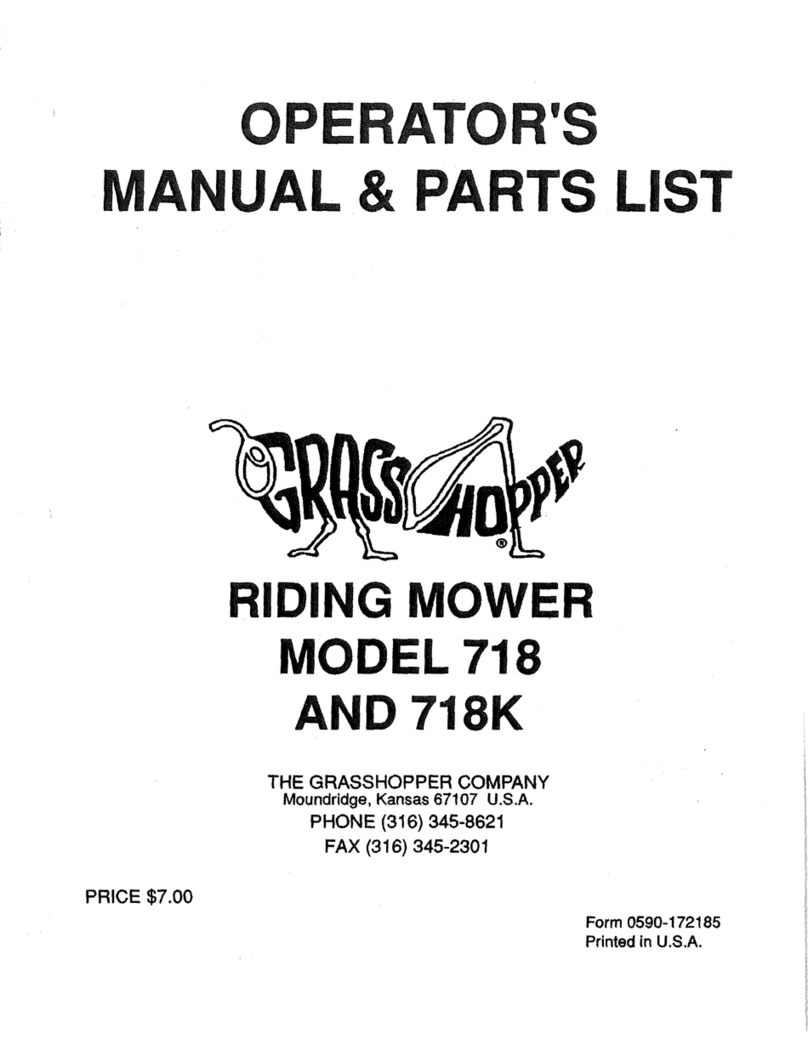
Grasshopper
Grasshopper 718 Installation and operation manual
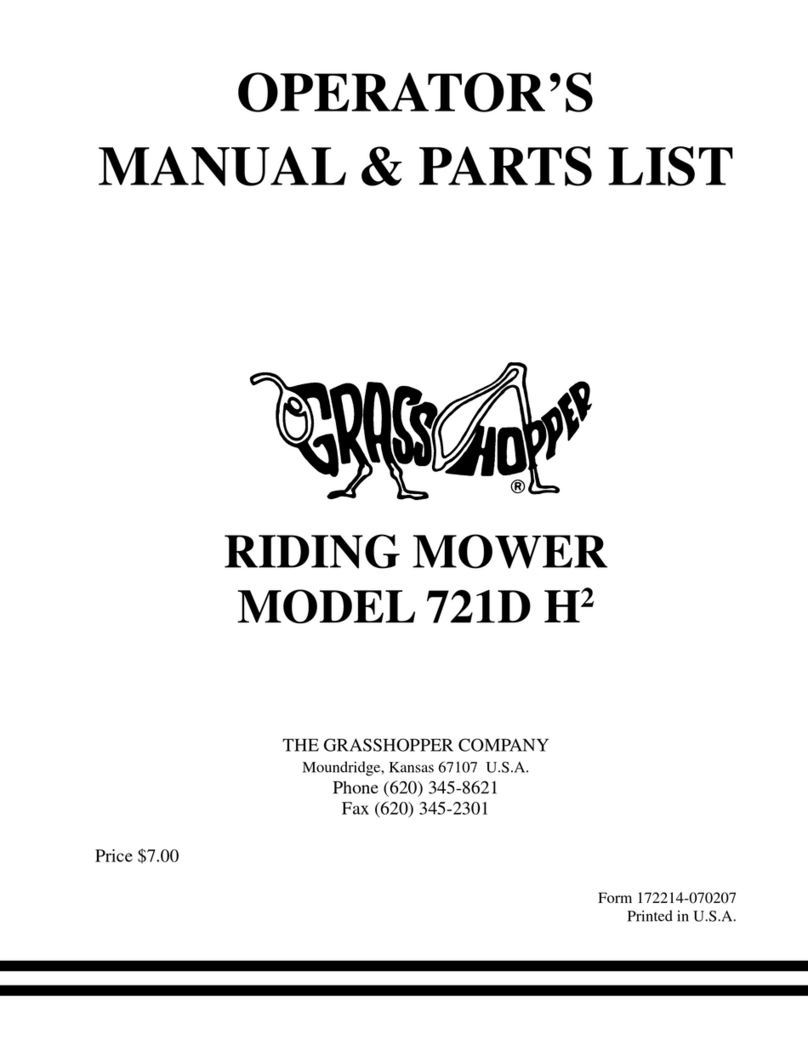
Grasshopper
Grasshopper 721D H2 Installation and operation manual
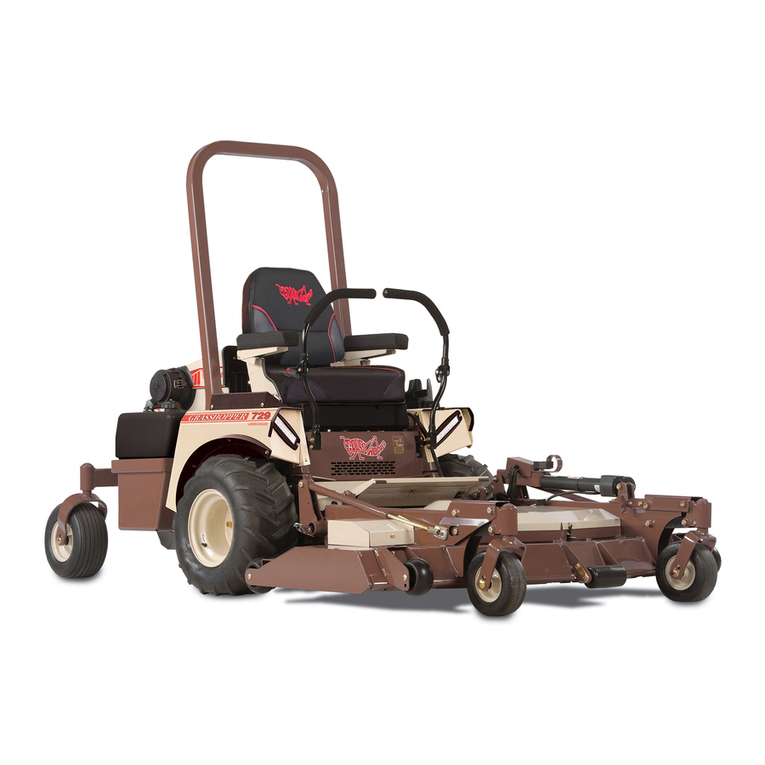
Grasshopper
Grasshopper 720 User manual


